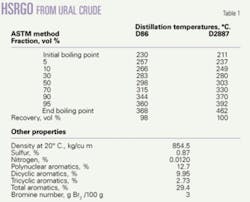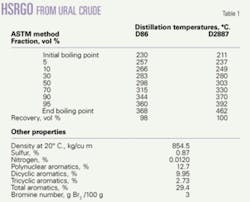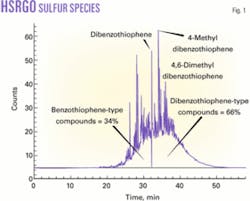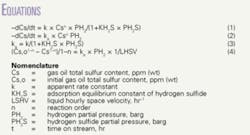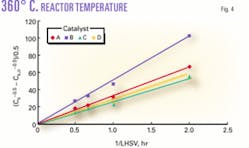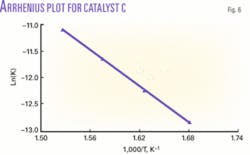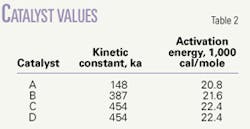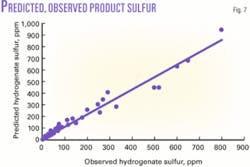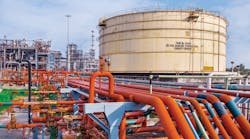A recent study of four commercial hydrodesulfurization (HDS) catalysts found that using the most active one for ultralow-sulfur diesel (ULSD) production resulted in significant economic benefits.
The study used heavy, straight-run gas oil (HSRGO) distilled from Urals crude, and hydrotreated it with four commercial catalysts at the conditions prevalent in conventional hydrotreating units operating at low pressure. The catalysts are among the most active currently available. The investigations showed that ultradeep HDS of the HSRGO on the catalysts tested is best described by 1.5-order reaction kinetics. The investigated catalysts exhibited remarkably different activities. A refiner can realize a benefit of about $2 million/year if the most active catalyst is selected for production of ULSD in a commercial, 20,000-b/d hydrotreater.
Fuels markets
Predictions are that global hydrocarbon processing capacity will increase to 100 million b/d by 2015 from the current 83 million b/d. Although biofuels and other alternative fuel sources will play a larger energy role in the next decade, the world economy will still find itself oil-based for the foreseeable future. Distillate and gasoline volumes will account for the greatest percentage of each crude barrel consumed.1
The product pattern demand is different for the different global areas. The US is a gasoline-based energy market, while demand for diesel in West Europe and Asia significantly surpasses that of gasoline.
There is currently excess gasoline production capacity in Europe and a shortage of light gas oil (diesel). Gasoline is exported to the US and imports from Russia and East Europe help alleviate West Europe’s diesel shortage.2
Refiners are trying to produce fuels at the lowest possible cost while meeting the public’s requirement for environmentally friendly fuels. This is not easy due to currently high prices for crude oil and metals, which are used for catalyst manufacturing.
During the past 2 years, prices for hydrotreating catalysts have more than doubled. Because the main process currently used for producing ULSD is hydrotreating middle distillate fractions, the proper catalyst selection is important for cost-effective ULSD production.
Experimental
Table 1 shows the physical and chemical properties of the Urals-based HSRGO.
Fig. 1 shows the gas chromatography with atomic-emission-detection analysis for the HSRGO. It shows that 34% of the sulfur in the HSRGO is a benzothiophene-type compound and the rest are dibenzothiophenes.
The HSRGO was hydrotreated in a trickle-bed pilot plant at these conditions:
- Reactor inlet temperature of 320-380° C.
- Liquid hourly space velocity (LHSV) of 0.5-2 hr-1.
- Total reactor pressure of 3,500 Pa.
- A hydrogen containing gas-to-feed ratio of 250 cu m/cu m.
- A hydrogen content in treating gas of 99 vol %.
The hydrogen partial pressure at reactor temperatures of 320°, 340°, 360°, and 380° C. was 32.6, 31.8, 30.6, and 29.2 barg, respectively. Reference 3 describes the process testing procedure. Before testing, the catalysts were activated (sulfided in situ) strictly following the procedure of each catalyst producer.
Catalyst testing
ULDS production requires an understanding of the reactivities of the sulfur species contained in the 340+° C. fraction of the feed. This fraction contains the dibenzothiophenes (DBT) and, in particular, 4,6-dimethyl dibenzothiophene (DMDBT). DMDBT contains sterically hindered sulfur species that require partial hydrogenation before the sulfur can be removed via hydrogenation.
Fig. 1 indicates that the HSRGO from Urals crude contains relatively high amounts of refractory sulfur species. The ratio of DBTs to total sulfur is relatively high and is higher than that reported in the literature.
For example, Street reported a maximum level of 40% DBTs (for light cycle oil) in his work with middle distillates.4 This is much lower than 66% DBTs observed in the HSRGO from Urals crude.
This HRSGO should therefore be hard to desulfurize to ultralow levels.
We explored different kinetic models to describe the desulfurization reaction for trickle-phase operations.5-10 Some models use second-order reaction kinetics,5 whereas others use first-order kinetics.6-10 There are also reports for 1.5-order reaction kinetics.11
The kinetic model used in this study has the general form of Equation 1 (see equation box).
We used an Arrhenius form for the temperature dependence of k. For the Langmuir-Henshelwood factor, we assumed that sulfur species in the feed and H2S are equally strongly adsorbed on catalyst sites.
Because all the catalysts were tested with a feed that has the same sulfur content, we assumed that the term (1+KH2S × PH2S) was equal for all catalysts. Based on this assumption, Equation 1 was transformed into Equation 2.
Integrating Equation 2 and substituting the time on stream, t, with its equivalent, the reciprocal liquid hourly space velocity (LHSV), yields Equation 4. The best fit for this data set was obtained with n equal to 1.5.
null
null
null
null
Figs. 2-5 show graphs of 1.5-order reaction kinetics for the reactor temperatures studied. Fig. 6 shows the Arrhenius-form temperature dependence of ka for Catalyst C.
Table 2 summarizes the values ka0 (kinetic constant at time zero) and Ea (activation energy) of the catalysts studied.
Fig. 7 shows the observed vs. predicted sulfur content using Equation 2. The difference between observed and predicted product sulfur is within the repeatability of the sulfur determination method used in this work (ASTM D3120, repeatability of 28%).
We used the appropriate values of ka0 and Ea for an economic comparison.
For the economic estimation, we assumed:
- The capacity of the HDS unit is 20,000 b/d. One of the Lukoil Neftochim Bulgaria hydrotreaters that processes heavy middle distillates has the same capacity.12
- Catalyst costs were assumed to be $20/kg (first-quarter 2005 prices).
- A maximum of two catalyst regenerations/charge.
- A deactivation rate of 1.9° C./month. That deactivation rate was observed in the Lukoil Neftochim Bulgaria heavy middle distillate hydrotreater with one of the tested catalysts.
- An end-of-run temperature of 390° C.
- The catalyst activity loss resulting from ex situ regeneration was assumed to be the same.
- Catalyst regeneration is performed ex situ and the HDS unit downtime for catalyst unloading and reloading, including the time necessary for regeneration is 10 days. This figure is based on our field experience.
We estimated unrealized benefit from the 10 days’ HDS unit downtime using a refinery linear programming model to be $1,367,000 due to loss of production.
We examined two scenarios: production of 50-ppm sulfur diesel at a LHSV of 1.625 hr-1, the LHSV of the Lukoil Neftochim HDS unit, and production of 10-ppm sulfur diesel at the optimal combination of start-of-run temperature (SORT) and catalyst volume
Table 3 presents the results of our economic estimation for Scenario 1. These data show that an economical benefit of $1,354,200 to $2,860,600 is possible if the most active catalyst is applied. About 70% of that benefit comes from the higher availability of the HDS unit, and 23% comes from the lower catalyst costs. Regeneration costs have the least impact on total costs.
For Scenario 2, we used an optimization procedure to find the optimal combination of SORT and LHSV (catalyst volume) at minimum cost.
Table 4 shows the results of our economic estimation for Scenario 2. These data show that the required catalyst volume for producing 10-ppm sulfur diesel is nearly twice that necessary to produce 50-ppm diesel.
For Scenario 2, the economic benefit of using the most active catalyst was between $310,800 and $538,000. About 75% of that effect comes from lower catalyst costs, 13% from lower catalyst regeneration costs, and 12% from higher HDS unit availability. These data show that the production of 10-ppm diesel requires a revamp or a new HDS unit to double the catalyst volume.
We did not examine the effects of higher reactor pressure (higher hydrogen partial pressure) on production of 50-ppm and 10-ppm sulfur diesel. It is well known, however, that an increase of the hydrogen partial pressure results in lower catalyst volume required for production of 10-ppm sulfur diesel and a lower catalyst deactivation rate.
A refiner could realize a total benefit of about $2,000,000/year if the most active catalyst is selected for producing ULSD in a commercial, 20,000-b/d hydrotreater.
References
- Gonzalez, R., “Reliability challenges,” Petroleum Technology Quarterly, Autumn 2005, p. 3.
- Swaty, T.E., “Global refining industry trends: the present and future,” Hydrocarbon Processing, September 2005, p. 35.
- Stratiev, D., Ivanov, A., and Jelyaskova, M., “Effect of feedstock end boiling point on product sulphur during ultra deep diesel hydrodesulphurization,” Oil & Gas European Magazine, April 2004, p. 188.
- Street, R., Allen, L., Swain, J., and Torrisi, S., “Optimising potential returns,” Hydrocarbon Engineering, March 2002, p. 29.
- Lawler, D., and Robinson, S., “Update hydrotreaters to process green diesel,” Hydrocarbon Processing, November 2001, p. 61.
- Knudsen, K., Cooper, B.H., and Topsoe, H., “Catalyst and process technologies for ultra low sulfur diesel,” Applied Catalysis A: General, Vol. 189 (1999), p. 205.
- Vanrysselberghe, V., and Froment, G.F., “Kinetic modeling of hydrodesulfurization of oil fractions: light cycle oil,” Ind. Eng. Chem. Res., Vol. 37 (1998), p. 4231.
- Kabe, T., Ishihara, A., and Tajima, H., “Hydrodesulfurization of sulfur-containing polyaromatic compounds in light oil,” Ind. Eng. Chem. Res., Vol. 31 (1992), p. 1577.
- Kabe, T., Ishihara, A., Zhang, Q., Tsutsui, H., and Tajima, H., “Deep desulfurization of light oil (Part 1) Hydrodesulfurization of methyl-substituted benzothiophenes and dibenzothophenes in light gas oil,” J. Jpn. Petrol. Inst., Vol. 36 (1993), p. 47.
- Hu, M.C., Ring, Z., Briker, J., and Te, M., “Rigorous hydrotreater simulation,” Petroleum Technology Quarterly, Spring 2002, p. 87.
- Laredo, G.C., Saint-Martin, R., Martinez , M.C., Castillo, J., and Cano, J.L., “High quality diesel by hydrotreating of atmospheric gas oil/light cycle oil blends,” Fuel, Vol. 83, Issue 10, July 2004, p. 1381.
- Petrov, S., Stratiev, D., Popov, N., Minkov, D., and Donov, A., “Low sulfur and low aromatic diesel fuel oil production at Lukoil Neftochim Bourgas,” presented to the International Petroleum Conference, Bratislava, Slovakia, Oct. 6-8, 2003.
The authors
Dicho Stratiev (Stratiev.Dicho @neftochin.bg) is the research and development department manager for Lukoil Neftochim Bourgas, Bourgas, Bulgaria. He joined Lukoil Neftochim Bourgas in 1990 as a process engineer in the catalysis laboratory in Lukoil’s Research Institute for Oil Refining and Petrochemistry. During his 16 years with Lukoil Neftochim, he was a process engineer on the visbreaker, vacuum distillation, and FCC units. Since 2002, Stratiev has been the deputy director of the Research Institute for Oil Refining and Petrochemistry. He took his current position in 2004. Stratiev holds an MS in organic chemistry engineering and a PhD in petroleum refining from Bourgas University.
Vladimir Galkin is the manager of the future development department for Lukoil Neftochim Bourgas, Bourgas, Bulgaria. He started his career in the research laboratory of the Omsk refinery for OAO Sibneft. In 2001 he was appointed as a manager of the research laboratory for Lukoil Neftochim and has held his current position since 2003. Galkin holds an MSc (1994) in chemical engineering from Omsk State University, Russia.
Kiril Stanulov is an associate professor and PhD rector at the University of Chemical Technology and Metallurgy, Sofia, Bulgaria. He teaches in the synthesis and fuels department in the field of oil refining and lubricants. He has authored more than 70 scientific papers and co-authored books on the technology of fuels production, methods for estimating of fuel properties, and a reference book for lubricants and cooling agents.
